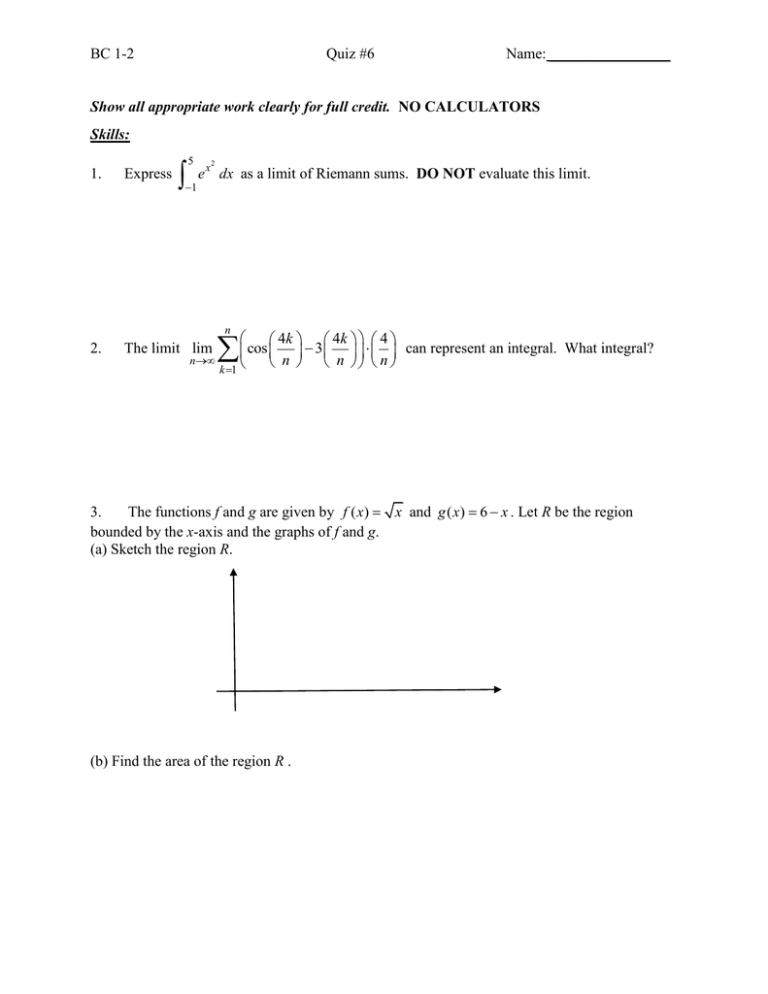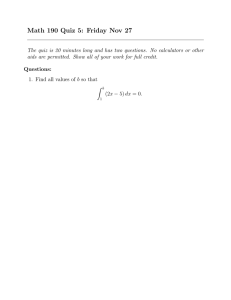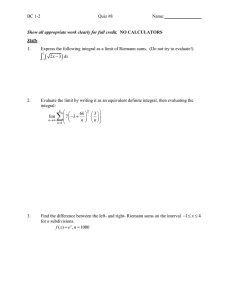Chapter Six Sample Quiz
advertisement

BC 1-2 Quiz #6 Name: ________________ Show all appropriate work clearly for full credit. NO CALCULATORS Skills: 1. Express 5 1 2 e x dx as a limit of Riemann sums. DO NOT evaluate this limit. n 2. The limit lim n 4k cos n 3 n n 4k 4 can represent an integral. What integral? k 1 3. The functions f and g are given by f ( x) x and g ( x) 6 x . Let R be the region bounded by the x-axis and the graphs of f and g. (a) Sketch the region R. (b) Find the area of the region R . BC 1-2 Quiz #6 Name: ________________ 2011 AP® CALCULUS BC FREE-RESPONSE QUESTIONS (4, 1) (3, 3) 4. The continuous function f is defined on the interval [4,3] . The graph consists of two quarter x circles and one line segment as shown in the figure above. Let g ( x) 2 x f (t ) dt . 0 a. Find g ( 3) . b. Find g ( x) , and then evaluate g (3) . c. Determine the x-coordinate of the point(s) at which g has an absolute maximum on the interval [ 4,3] . Justify your answer. d. Find all values x (4,3) for which the graph of g has an inflection point. Give a reason for your answer. e. Find the average rate of change of f on the interval [4,3] . There is no point c, 4 c 3 for which f (c ) is equal to that average rate of change. Explain why this statement does not contradict the Mean Value Theorem. BC 1-2 Quiz #6 Name: ________________ 5. Evaluate: sin x dx 0 8 6. Evaluate the integral 3 3 f ( x) dx given that f is even, 3 8 f ( x) dx 5 , and f ( x) dx 2 . 8 7. Given the graph of f below, sketch the graphs of f and f on the same axes assuming that all three graphs go through the origin. Clearly mark each graph. y f ( x ) BC 1-2 Concepts: x 2 sin(t t ) dt 8. Evaluate: lim x x 0 x3 Quiz #6 Name: ________________ BC 1-2 Quiz #6 x Name: ________________ 1 dt . You may recognize L as a function that we have seen before; in t 1 fact L( x) ln( x) . Using only the integral definition of L ( x ) , try to state/prove some properties of L. 10. For x 0, let L( x) a. b. c. d. e. f. g. L(1) L( x ) Where is L positive? Negative? Where is L increasing? Decreasing? Where is L concave up? Down? L( x y ) L(2n ) h. lim L( x) x



